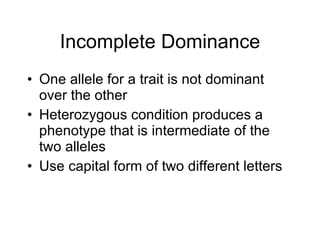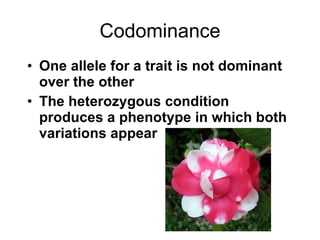Genetic Crosses
- 2. Incomplete Dominance One allele for a trait is not dominant over the other Heterozygous condition produces a phenotype that is intermediate of the two alleles Use capital form of two different letters
- 3. Incomplete Dominance Red Snaps White Snaps RR WW RW All Pink RW X RW
- 4. Codominance One allele for a trait is not dominant over the other The heterozygous condition produces a phenotype in which both variations appear
- 5. Codominance
- 6. Try these two In cats when a long tailed cat is bred with a no tailed cats short tailed cats are produced. If a short tailed cat was bred with a no tailed cat, what is the likelihood that a short tailed cat would be produced? Is this incomplete or codominance? 2) Also in cats a black haired cat and a white haired cat produce a tuxedo (mix of black and white). If a two tuxedo cats were bred, what would be the likelihood of producing a white cat? Is this incomplete or codominance.
- 7. Sex-Linked Traits Activity Hemophiliac Male X h Y Normal Male X H Y Hemophiliac Female X h X h Carrier Female X H X h Normal Female X H X H Overall Total Group Total Phenotype Genotype
- 8. Sex Linked Traits Traits that have a gene (allele) located on a sex-chromosome. Most traits the gene is located on the X chromosome Since males have only one of two X chromosomes they only need one recessive gene to carry the trait. Must include sex chromosome in cross Examples are colorblindness and hemophilia
- 10. Sex-linked Trait example Normal vision is dominant to colorblindness. A heterozygous (carrier) female marries a normal male.
- 11. 3-2-1 Think about List 3 human traits that seem to have a range of possible variations (rather than simply 2 or even 3 distinct variations) Describe 2 reasons why you think traits could have a range of variations Give one definition for the word POLYGENIC
- 12. Polygenic Traits Traits controlled by more than one gene. Usually creates a range of variations possible Examples: Eye color, skin color, hair color, height See Child/Grandchild lab for examples
- 13. Answer the following How similar or different does your child look compared to you in terms of hair, eye, or skin color? How could the genotypes of the child change to make them look more/less similar than you?
- 14. Multiple Alleles More than two alleles (gene variations) for a trait. Example A B O blood types
- 15. Blood Type Donate /Receive ii O I A I B AB I B I B I B i B I A I A I A i A Antibody for: Antigen on Blood Genotype Blood Type
- 16. Blood Type Examples A woman with O blood and man with A blood marry. Could they have a child with O blood? Could it be possible that there is no chance of having children with O blood? A man with B blood marries a woman with AB blood. They have a child with A blood. What has to be dads genotype? Prove it. A man with A blood (I A I A ) and woman with B blood (I B I B ) have a child. The child needs a blood transfusion. Do they need to worry about the child getting the wrong type of blood? Why or why not?















